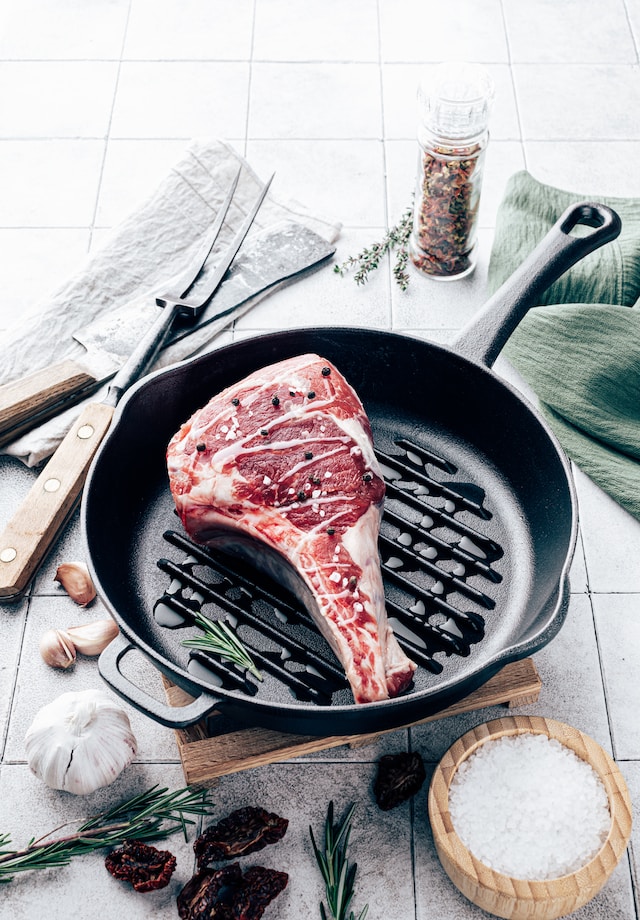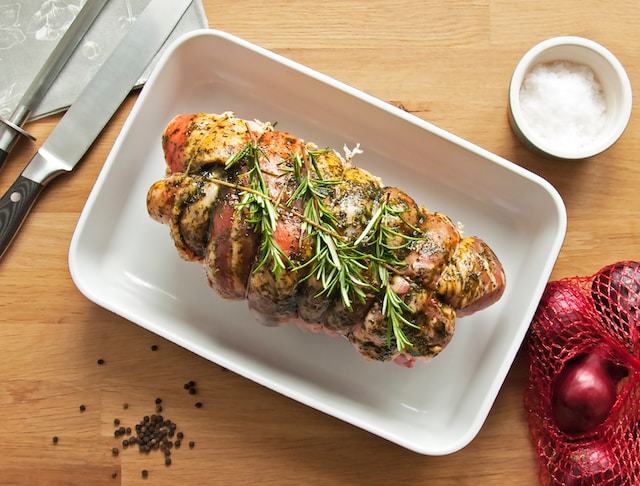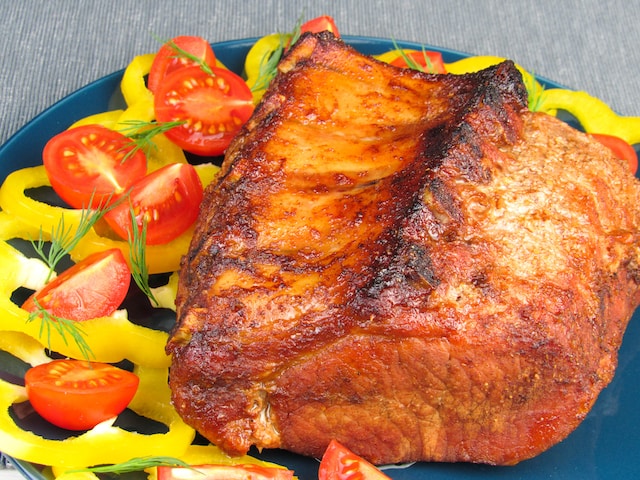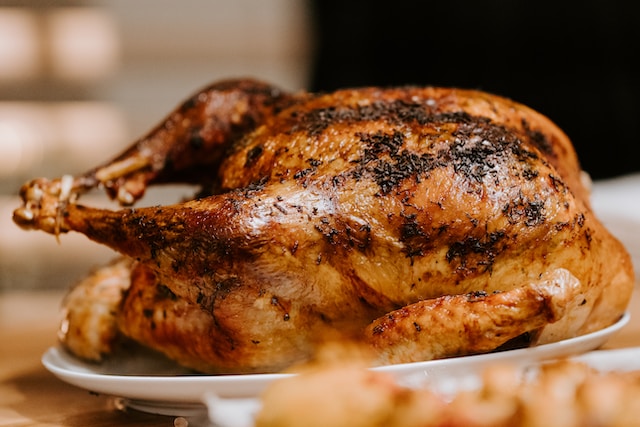
Few combinations captivate the senses quite like the marriage of herb-roasted meats and vegetables. This age-old technique has stood the test of time, gracing kitchens with its irresistible aromas and creating delectable dishes that have become the stuff of legends.
The art of roasting meats and vegetables with herbs is a testament to the power of simplicity. Simply put, The allure of a well-roasted dish prepared with skill and care remains timeless.
Roasting allows the natural sugars within meats and vegetables to caramelize, creating a delightful medley of textures and flavors that are both hearty and satisfying. The careful interplay between tender meats and perfectly roasted vegetables is a dance on the palate that transports us to a realm of gastronomic pleasure.
Herbs, those humble yet extraordinary botanical wonders, elevate these dishes to new heights. Whether it be the earthy undertones of rosemary, the delicate freshness of thyme, or the pungent allure of oregano, each herb lends its unique character to the medley of flavors, enhancing the overall depth and complexity of the dish.
Selecting Herbs for Roasting
When it comes to choosing the perfect herbs to complement your herb-roasted meats and vegetables, a careful selection is key. Each herb brings its own distinct personality to the dish, and understanding their flavors will help you create a harmonious symphony on your plate.
Rosemary
One of the most popular herbs used in roasting, rosemary, with its pine-like aroma and robust flavor, adds a touch of earthiness to your dish. Its sharp, woody notes showcase its versatility, enhancing the natural flavors of both meats and vegetables. Sprinkle a few sprigs over your lamb or chicken for an aromatic awakening that indulges the senses.
Thyme
With its delicate leaves and subtle lemony undertones, thyme brings a gentle yet indispensable presence to herb-roasted creations. Its fragrant bouquet blends seamlessly with poultry, beef, or roasted root vegetables, enhancing their essence with a touch of freshness. In the realm of herbs, thyme is the unsung hero, subtly elevating the dish without overpowering its companions.
Oregano
For those seeking a bolder flavor profile, oregano is the herb of choice. With its strikingly pungent aroma and assertive taste, oregano adds depth and character to herb-roasted meats and vegetables. Often associated with Mediterranean cuisine, this herb works wonders with lamb, chicken, or tomatoes, infusing them with its distinctive personality that leaves an impression on the palate.
Sage
Sage, with its velvety leaves and musky undertones, brings an air of sophistication to herb-roasted delights. Its warm and savory essence enhances the flavors of poultry, pork, or autumnal vegetables, offering a delicate balance between richness and herbaceousness. Just a few sage leaves can transform an ordinary dish into a gastronomic adventure.
Fresh Vs. Dried Herbs for Roasts
When it comes to selecting herbs for roasting, the choice between fresh and dried can be a perplexing one. Both options offer their own distinct advantages, and understanding the differences will help you make an informed decision.

Fresh herbs, with their vibrant colors and fragrant aromas, are a delightful addition to any dish. When used in herb-roasted meats and vegetables, they provide a burst of flavor that enlivens the senses. The moisture content in fresh herbs ensures that they stay tender during the roasting process, releasing their essential oils and infusing the dish with their characteristic taste.
Dried herbs, on the other hand, offer a longer shelf life and are convenient to have on hand at all times. While they may not possess the same intensity of flavor as their fresh counterparts, dried herbs have a concentrated essence that can withstand the high temperatures of roasting. Additionally, they are ideal for dishes that require longer cooking times, as their flavors develop and meld with the other ingredients over time.
Ultimately, the decision between fresh and dried herbs comes down to personal preference and the desired flavor profile of your dish. If you have access to fresh herbs, it is recommended to use them for their vibrant flavors and aromatic qualities. However, if fresh herbs are not readily available or you prefer the convenience of dried herbs, they can still impart a rich and nuanced taste to your herb-roasted creations.
Preparing Your Ingredients
Selecting the right meats and vegetables for your herb-roasted dish is crucial to achieving mouthwatering results. Opt for high-quality cuts of meat that are tender and well-marbled, such as lamb chops, beef tenderloin, or chicken thighs.

When it comes to vegetables, choose those that hold up well to roasting and can absorb the herb-infused flavors. Root vegetables like potatoes, carrots, and parsnips lend a hearty and satisfying aspect to the dish, while Brussels sprouts, bell peppers, and zucchini add a vibrant touch. Be sure to wash and trim your vegetables before proceeding with the recipe.
Prepping the Herbs
Whether you’ve decided to use fresh or dried herbs, proper preparation is essential to ensure their flavors are maximized. For fresh herbs, gently wash them under cold water to remove any dirt or debris. Pat them dry with a clean kitchen towel or paper towel to prevent excess moisture during roasting. Remove the leaves from the stems and chop or tear them into smaller pieces, releasing their aromatic oils.
If using dried herbs, there is no need to wash or dry them. However, it is advisable to crumble the dried herbs between your fingers to release their full potential. This step will enable the dried herbs to infuse their concentrated flavor throughout the entire dish.
Coating Your Meats and Vegetables
Now that your meats, vegetables, and herbs are prepped, it’s time to bring them together in a flavorful embrace. Begin by drizzling your meats and vegetables with a high-quality olive oil, ensuring a light and even coating. This will help the herbs stick to the surface, ensuring maximum flavor infusion.
Next, generously sprinkle your chosen herbs over the meats and vegetables, making sure to distribute them evenly. Gently massage the herbs into the ingredients, ensuring that every nook and cranny is touched by their aromatic essence. Allow the herb-coated meats and vegetables to rest for a few minutes, allowing the flavors to meld together.
Recipe Ideas
Herb-Roasted Chicken with Root Vegetables

Ingredients:
- 1 whole chicken, approximately 3-4 pounds
- 4-5 sprigs of rosemary
- 4-5 sprigs of thyme
- 4-5 cloves of garlic, minced
- 2 carrots, peeled and cut into 1-inch chunks
- 2 parsnips, peeled and cut into 1-inch chunks
- 1 onion, sliced
- Olive oil
- Salt and pepper to taste
Instructions:
1. Preheat the oven to 425°F (220°C).
2. Pat the chicken dry with a paper towel. Place the chicken on a roasting rack set inside a roasting pan.
3. In a small bowl, mix together the minced garlic, salt, pepper, and a drizzle of olive oil.
4. Rub the garlic mixture all over the chicken, ensuring it is evenly coated.
5. Stuff the cavity of the chicken with a few sprigs of rosemary and thyme.
6. In a separate bowl, toss the carrots, parsnips, and onion with olive oil, salt, and pepper.
7. Arrange the vegetables around the chicken in the roasting pan.
8. Sprinkle the remaining rosemary and thyme leaves over the chicken and vegetables.
9. Place the roasting pan in the preheated oven and roast for approximately 1 hour, or until the chicken reaches an internal temperature of 165°F (74°C).
10. Remove the chicken from the oven and let it rest for 10 minutes before carving. Serve with the roasted vegetables on the side.
Herb-Roasted Lamb Chops with Brussels Sprouts

Ingredients:
- 8 lamb chops
- 4-5 sprigs of rosemary
- 4-5 sprigs of thyme
- 4-5 sprigs of oregano
- 2 cloves of garlic, minced
- 1 pound Brussels sprouts, trimmed and halved
- Olive oil
- Salt and pepper to taste
Instructions:
1. Preheat the oven to 400°F (200°C).
2. Season the lamb chops with salt, pepper, and minced garlic, ensuring they are well-coated.
3. In a skillet over medium-high heat, heat olive oil. Sear the lamb chops on both sides until browned, approximately 2-3 minutes per side.
4. Transfer the seared lamb chops to a baking sheet lined with parchment paper or a greased wire rack.
5. In a small bowl, combine the minced garlic, chopped rosemary, thyme, and oregano. Drizzle with olive oil and mix well.
6. Brush the herb mixture over the lamb chops, ensuring they are evenly covered.
7. Toss the Brussels sprouts in a separate bowl with olive oil, salt, and pepper.
8. Arrange the Brussels sprouts around the lamb chops on the baking sheet.
9. Place the baking sheet in the preheated oven and roast for approximately 12-15 minutes for medium-rare lamb chops or longer for desired doneness.
10. Remove the lamb chops from the oven and let them rest for a few minutes. Serve with the roasted Brussels sprouts as a delicious side dish.
These recipes are just a starting point for your herb-roasted culinary adventures. Don’t be afraid to experiment with different combinations of meat, vegetables, and herbs to create your own signature dishes. Whether it’s a cozy family dinner or a special occasion, herb-roasted meats and vegetables will never fail to impress and delight.
